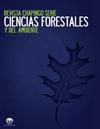两种红松林土壤无机氮脉动与叶片氮吸收。森林
IF 0.6
4区 农林科学
Q3 Agricultural and Biological Sciences
Revista Chapingo Serie Ciencias Forestales Y Del Ambiente
Pub Date : 2022-04-30
DOI:10.5154/r.rchscfa.2021.02.010
引用次数: 0
摘要
简介:高山森林中的营养物质运动产生了关于其功能和对气候变化影响的反应的信息。这些生态系统中的氮动力学研究很少。目的:量化墨西哥中部JocotiláN(JO)和Tláloc(Tl)山区森林垃圾、表层土(0-10 cm)和针叶落叶中的氮库,并测量表层土中硝酸盐和铵的时间浓度和氮吸收(ReabsN)。材料和方法。在一年的时间里,共收集了108个(JO)和128个(TL)土壤和针头落叶样本。采用Wilcoxon检验方法比较了不同山地的N和ReabsN水库(P<0.05),并以时间和山地为固定因子,采用线性混合模型分析了土壤水分、N和ReabsN形态的时间趋势。结果和讨论。山区之间的重量水分、总氮、硝酸盐和铵浓度没有差异。JO中的总无机氮(铵+硝酸盐)高于TL(46对41 mg∙kg-1)。JO中针落叶和土壤中的N较高,但TL中的ReabsN较高(60%对55%)。土壤水分、铵和ReabsN呈三次趋势(P<0.05),表现为N脉冲。结论。森林在氮的枯枝落叶、吸收和土壤无机形式方面表现出不同的氮动力学,这表明有可能根据这种营养来区分它们的功能。本文章由计算机程序翻译,如有差异,请以英文原文为准。
Soil inorganic nitrogen pulses and leaf nitrogen resorption in two Pinus hartwegii Lindl. forests
Introduction: Nutrient movement in high mountain forests generates information on their functioning and response to climate change effects. Nitrogen dynamics in these ecosystems has been poorly studied. Objective: To quantify N reservoirs in forest litter, topsoil (0-10 cm) and needle litterfall, and to measure temporal concentrations of nitrate and ammonium in topsoil and N resorption (ReabsN) in the Jocotilán (JO) and Tláloc (TL) mountains of central Mexico. Materials and methods. A total of 108 (JO) and 128 (TL) soil and needle litterfall samples were collected for one year. N and ReabsN reservoirs were compared between mountains using the Wilcoxon test (P < 0.05). Temporal trends of soil moisture, N and ReabsN forms were analyzed with linear mixed models, setting time and mountain as fixed factors. Results and discussion. Gravimetric moisture, total N, and nitrate and ammonium concentrations were not different between mountains. Total inorganic N (ammonium + nitrate) in JO was higher than in TL (46 vs. 41 mg∙kg-1). N in needle litterfall and soil were higher in JO, but ReabsN in TL was higher (60 vs. 55 %). Soil moisture, ammonium and ReabsN had a seasonal pattern of cubic trend (P < 0.05), denoting N pulses. Conclusions. Forests showed differences in N dynamics in needle litterfall, resorption and soil inorganic forms of N, indicating that it is possible to differentiate their functioning according to this nutrient.
求助全文
通过发布文献求助,成功后即可免费获取论文全文。
去求助
来源期刊
CiteScore
1.20
自引率
16.70%
发文量
0
审稿时长
>12 weeks
期刊介绍:
The Revista Chapingo Serie Ciencias Forestales y del Ambiente (RCHSCFA) is a scientific journal that aims to raise awareness of high-quality research products related to forest, arid, temperate and tropical environments in the world. Since its foundation in 1994, the RCHSCFA has served as a space for scientific dissemination and discussion at a national and international level among academics, researchers, undergraduate and graduate students, forest managers and public/private entities that are interested in the forest environment.
All content published in the journal first goes through a strict triple-blind review process and is published in the following formats: Scientific Articles, Review Articles, Methodologies, Technical or Technological Notes.

 求助内容:
求助内容: 应助结果提醒方式:
应助结果提醒方式:


